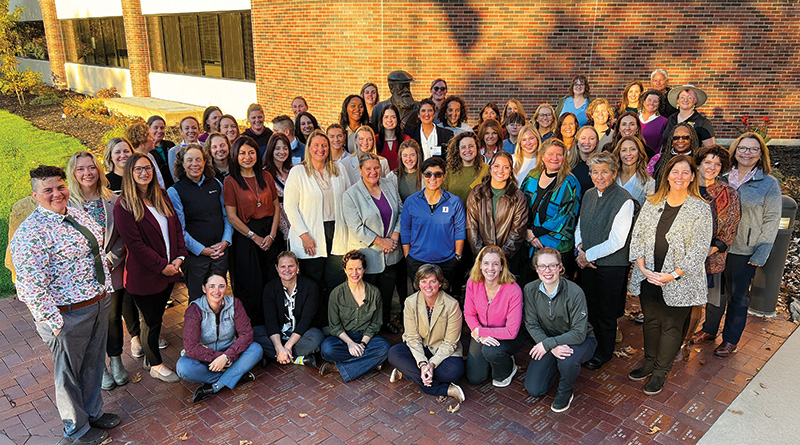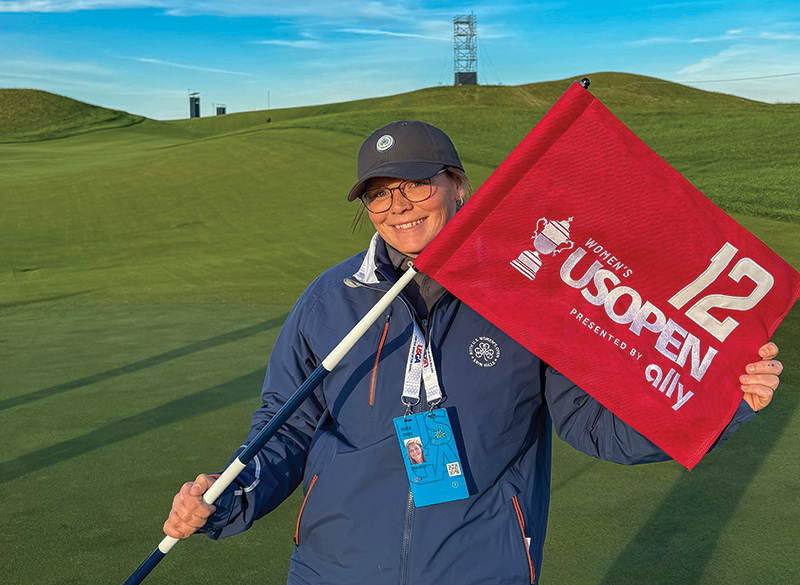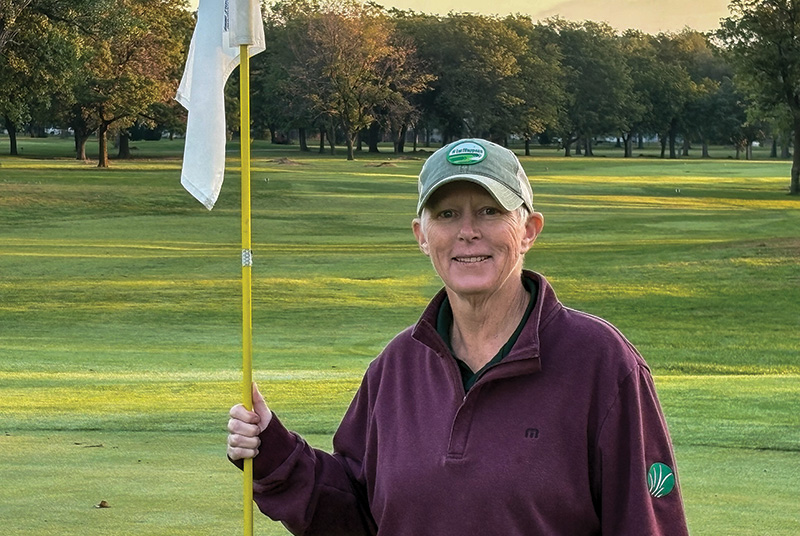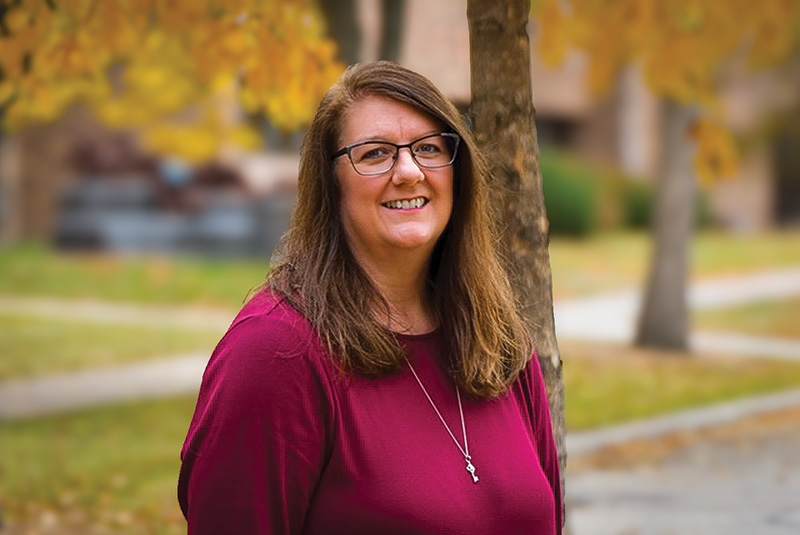
GCSAA headquarters in Lawrence, Kan., hosted the second Women’s Leadership Academy last November. The third WLA will return Nov. 11-13.
GCM file photo
Later this month, 37 female turfgrass professionals will report to GCSAA headquarters in Lawrence, Kan., for the third Women’s Leadership Academy.
The education and networking event will run Nov. 11-13 and begin with a keynote presentation by Suzy Whaley, a PGA Master Professional and the first woman to serve as president of the PGA of America.
The 2½-day event will include sessions on leadership, communication, health and wellness, and more.
The 37 invitees are a diverse lot, including students, greenkeepers, assistant superintendents, an equipment manager, a Certified Golf Course Superintendent, a veteran professor, chapter executives and more.
The Women’s Leadership Academy is hosted and paid for by GCSAA based on the support of industry benefactors, including The Toro Co. and Yamaha Golf-Car Co., who support the event as Trailblazer benefactors; PBI-Gordon, Syngenta and Target Specialty Products as Pathfinder benefactors. The event is endorsed by the Sports Field Management Association.
Here are the stories of a handful of the women who will attend:

Felicia Childs
Assistant superintendent
Bucks Run Golf Club, Mt. Pleasant, Mich.
Felicia Childs feels quite fortunate to have landed in the golf course maintenance profession.
“Honestly,” she says, “I’ve been very blessed with how everything fell into my lap.”
From childhood, Childs, a two-year member of GCSAA, wanted to own a daycare. She headed off to school and got an associate degree in business — the “bare minimum,” she said, to be certified as a special education paraprofessional — and worked as a para during the school year.
“I was in need of a summer job,” Childs said. “So I started as a regular grounds crew member. It’s funny. When I went to my interview for my current job, I thought I was going to be a bev cart girl for the summer. During the interview, I thought, ‘This is definitely not the bev cart,’ but I tried it anyway.”
Her first day on the job was … memorable.
“It was so cold and raining,” Childs recalls. “I almost didn’t come back. But I gave it a shot and fell in love with the place. Every summer, I came back and realized I really enjoy being outside and didn’t want to have to go back inside when the school year comes. I showed more and more interest, and my boss said, ‘Let’s see what you can do.’ He promoted me, and my golf course actually paid for me to get my schooling done online through Oregon State.”
Childs says she has followed the Women in Turf online network and has met several women through volunteering, including a trip to the U.S. Women’s Open this spring at Erin Hills in Erin, Wis. She hopes to expand her network through the WLA.
“Basically, there’s this little group of us, Women in Turf, and through volunteering, each time I do it I meet new women,” Childs says. “It’s cool to be able to meet people from all over the place who are all doing the same thing. It’s basically a really, really good social networking opportunity. I recognize a few names on the list. I’m excited to put faces to names.”

Kat Couch
Assistant golf course superintendent
MacDonald Golf Course, Wichita, Kan.
Kat Couch, a three-year GCSAA member, has a very specific reason for wanting to attend the WLA.
“I hopefully will have the opportunity to apply for the superintendent position where I’m at,” says Couch, a 20-plus-year assistant. “My boss is ready to retire. I’m hoping to gain some skills from this leadership academy to help me nail that job.”
An Arizona native who went to college planning to become a teacher, Couch graduated from Northern Arizona University and found it impossible to find a job in her intended field. “Now they’re banging on doors wanting teachers,” she says.
A sister of hers was working in food and beverage at a resort on Hilton Head Island, S.C., and she invited Couch to join her there.
“I’d never been around golf my entire life,” Couch says. “But she said, ‘Why don’t you come out and see me and work on the golf course?’”
Couch originally interviewed for a job in the clubhouse.
“That wasn’t for me,” she says. “I’d see the guys in maintenance and think, ‘That’s what I want to do. I want to watch the sun come up. I want to be in the grass.’ So I talked to the superintendent. He said he needed somebody to mow fairways, and that’s all she wrote. I fell in love with it.”
And how does a female teacher-turned-greenkeeper from Arizona go from the South Carolina Lowcountry to middle America? First, she followed her Hilton Head sister to Chicago and “hated it.”
However …
“I had another sister,” Couch says with a laugh. “Thank goodness for family. She lived in Wichita. She said, ‘Why don’t you come to Wichita? I have an apartment and a car.’ She traveled all the time. I got a seasonal part-time job at one of the country clubs here. Then I saw an ad in a little newspaper Wichita used to have, the PennySaver. There was an ad for a full-time laborer position at one of the public golf courses in Wichita. I went from laborer to greenkeeper to assistant, and I’ve been an assistant for 22, 23 years.”
Couch has worked for the City of Wichita for 26 years and twice before has applied for a head superintendent job.
“I wasn’t chosen, but that’s OK,” she says.
She hopes her time at the WLA will help her strengthen her soft skills — like leadership and communication (“That’s the hardest part of the job,” Couch says).
“I want to push myself outside of my comfort zone. I wanted to make myself and my family and my organization proud by being selected,” she says. “I’ve always been the go-to-work-do-the-job-go-home type, and I wanted to step outside those boundaries and be with other women in this industry. I’m really excited about that.”

Carey Hofner, CGCS
Golf course superintendent
Happy Ranch, Big Sky, Mont.
Folks might take a look at Carey Hofner, see the initials after her name, appreciate her two decades in the industry … and think she’s got this profession all figured out.
“Everyone thinks I’m so confident,” says Hofner, a 19-year GCSAA member. “I’m really not. People see someone who goes to grad school twice, someone who can do a grow-in. But there are a lot of unseen things people don’t see.”
Hofner, who tends to an exclusive, private, par-3 18-hole course in Montana that sees maybe 100 rounds a season (“It’s just the owner, his family and friends,” she says), admits she “likes to be in her own little hole.”
She sees the Women’s Leadership Academy as a way to push herself personally as well as professionally.
“I definitely hope to get some confidence and some new connections out of it,” she says. “Looking at the list, I only know two people who are going to be there. So I’m looking forward to meeting new people, especially the younger ones coming in and those from different walks of life. It’s OK if you feel lost at times. We’ve all been there.”
Hofner fell into golf through the National FFA Organization. She stumbled onto turf as a “better project than raising livestock,” she says. “That wasn’t making any money.”
Her brother’s best friend was a superintendent at a local course, so Hofner asked if she could perform her FFA Supervised Agricultural Experience there.
“He was like, ‘Sure,’” Hofner recalls. “That’s how I fell into it, but it still wasn’t my career choice. I think I changed my major three times before I realized I liked being outside.”
Working on the athletic fields at Ohio State — where she earned her undergrad degree in agriculture with a turf emphasis, followed by a master’s in turfgrass management from Penn State University (not to mention the MBA program at Penn State she’s enrolled in now) — solidified her decision to pursue a career in golf course management.
“No two days are the same,” she says.
Hofner is thrilled to see GCSAA’s new connections with FFA.
“I remember having that conversation with somebody 10, 12 years ago,” she says. “I said, ‘You need to hit this market. It’s a market you don’t realize … growing up in some city schools, you can’t do livestock. That’s your market right now.’ It’s how I got my start in the industry.”
Hofner had considered applying to attend previous WLAs, but her work at Happy Ranch prevented it.
“I was like, ‘I’m doing a grow-in. I don’t know what’s going to happen. I should put my work first. My job needs to come first,’” she says. “One of the main reasons I applied this year was, there are lots of new faces, and I’m looking forward to meeting new people.”

Kristina Walker, Ph.D.
Professor of agronomy
University of Minnesota-Crookston
Twenty-five years ago, Kristina Walker landed her first job in golf. Though she had a lifelong interest in the sport, she didn’t consider making a career in it until after she graduated with a degree in psychology and went to work at a drug and alcohol rehabilitation center.
“It was too much for me to handle,” says Walker, a 22-year Educator member of GCSAA. “All I kept saying was, ‘I just want to be outside.’”
Thinking back to one of her first college courses, which discussed the aesthetics of turf and its impact on mental health, it finally clicked, and Walker joined a golf course crew, proved dependable and “asked a lot of questions.”
Walker thought she had found her calling.
“When I first started, I absolutely had thoughts that I’d be a superintendent,” she recalls. “I don’t think anybody would have been able to change my mind.”
Encouraged by her superintendent and assistant superintendent at the time, Walker went back to school to study turfgrass, eventually earning a master’s and doctorate — and discovering her true purpose.
“I have the perfect job,” says Walker, who says she’s the first woman to get a Ph.D. from Purdue in turfgrass management and the first woman to get tenured and promoted to full professor in her department at UMN-Crookston. “Even though I teach turf, I’m a little distant from it. I can take my class to the golf course. I can talk about disease and pest problems all day, but my job isn’t dependent on solving them.”
Why attend WLA? Walker thinks back to that golf course job a quarter century ago and recalls all the “crew guys” taking bets on how long Walker would stick it out. She outlasted them all.
“I’m trying to understand the challenges facing women in the golf industry,” Walker says. “I’m an adviser. In 17 years, I’ve had a total of five female students. Most of them haven’t stayed in the industry. Most of them went on to do something else. So I’m trying to understand why they don’t stay.
“The other thing is, I’m in a bit of a transition period. I just became a full professor. I’m about to turn 50. Looking back on my experience, I’m thinking I need to be better about supporting other women in the industry. And I also plan to use it as an opportunity to network. I’m wowed by the ladies on the list and the things they’re doing in turf.”
Walker does have one woman she advises who’s working on a golf course and appears headed toward a career in golf course maintenance. Walker took that student to a Sports Field Management Association conference, and they attended a session on women in the industry.
“That played a pivotal part in my applying for this (WLA),” Walker says. “I thought, ‘Maybe I don’t fully understand the challenges facing women in this industry.’ To advise my students better, I need to have a better understanding of the challenges they face.
Andrew Hartsock (ahartsock@gcsaa.org) is GCM’s editor-in-chief.